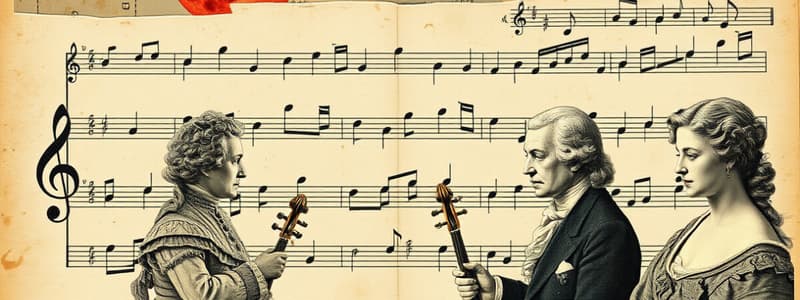Podcast
Questions and Answers
What years define the Classical Era?
What years define the Classical Era?
1750-1820
The three most important composers of the Classical Era are _____, ________, and __________.
The three most important composers of the Classical Era are _____, ________, and __________.
Haydn, Mozart, Beethoven
What was the most important city for music during the Classical Era?
What was the most important city for music during the Classical Era?
Vienna
One of the new opportunities for women during the Classical Era was Mozart's sister, ____________ ______ ___________.
One of the new opportunities for women during the Classical Era was Mozart's sister, ____________ ______ ___________.
What facilitated middle class access to music during the Classical period?
What facilitated middle class access to music during the Classical period?
__________ ______(1732 - 1809) spent most of his career working under the patronage system at the _____________ __________.
__________ ______(1732 - 1809) spent most of his career working under the patronage system at the _____________ __________.
A string quartet is an example of __________ music.
A string quartet is an example of __________ music.
What is the now obsolete instrument that Prince Nikolaus played?
What is the now obsolete instrument that Prince Nikolaus played?
What is music written for music's sake, not meant to represent something?
What is music written for music's sake, not meant to represent something?
The ____________ ________ _____________ form can be labeled as A A' A'' A''' A''''.
The ____________ ________ _____________ form can be labeled as A A' A'' A''' A''''.
An example of a musical joke is the _____________ ________________ composed by __________.
An example of a musical joke is the _____________ ________________ composed by __________.
After the Napoleonic armies invaded Vienna, __________ composed a patriotic piece called _______ ________ _____ _____________________ ____________.
After the Napoleonic armies invaded Vienna, __________ composed a patriotic piece called _______ ________ _____ _____________________ ____________.
The second movement in the piece associated with the Emperor String Quartet is in ____________ ________ ___________ form.
The second movement in the piece associated with the Emperor String Quartet is in ____________ ________ ___________ form.
The Classical Symphony evolved from what?
The Classical Symphony evolved from what?
The symphony began as 3 movements but was later expanded into _____________ movements by ___________.
The symphony began as 3 movements but was later expanded into _____________ movements by ___________.
The four main instrumental elements of the symphony are the: ____________, _______________, __________, and the _________________.
The four main instrumental elements of the symphony are the: ____________, _______________, __________, and the _________________.
What nickname has Haydn been given for his contributions to the symphony?
What nickname has Haydn been given for his contributions to the symphony?
The last 12 symphonies Haydn composed are nicknamed the ___________ symphonies.
The last 12 symphonies Haydn composed are nicknamed the ___________ symphonies.
What was different about the London symphonies?
What was different about the London symphonies?
Haydn's Symphony 100 has been nicknamed the ______________ Symphony because of the instrumentation.
Haydn's Symphony 100 has been nicknamed the ______________ Symphony because of the instrumentation.
New instruments added in Symphony 100 include: __________, ___________, ___________ ____________, and __________________ __________.
New instruments added in Symphony 100 include: __________, ___________, ___________ ____________, and __________________ __________.
The second movement of Haydn's Symphony 100 is in _____________ form.
The second movement of Haydn's Symphony 100 is in _____________ form.
Who was a child prodigy born in Salzburg, Austria in 1756?
Who was a child prodigy born in Salzburg, Austria in 1756?
After not enjoying the patronage system, ______________ would move to Vienna in 1781 to become a _________________ _____________.
After not enjoying the patronage system, ______________ would move to Vienna in 1781 to become a _________________ _____________.
What is the most popular musical form during the Classical period?
What is the most popular musical form during the Classical period?
The first section of sonata form is called the ______________.
The first section of sonata form is called the ______________.
The four themes in the exposition are 1.________ _________ 2.__________ 3._____________ _________ 4.__________ _____________
The four themes in the exposition are 1.________ _________ 2.__________ 3._____________ _________ 4.__________ _____________
What is the next section called in sonata form where tension is added?
What is the next section called in sonata form where tension is added?
What is the final section in sonata form referred to as?
What is the final section in sonata form referred to as?
Flashcards are hidden until you start studying
Study Notes
The Classical Era
- Timeframe: 1750-1820
- Key composers: Haydn, Mozart, Beethoven
- Prominent city for music: Vienna, Austria
Women in Music
- New opportunities for women, highlighted by Mozart's sister, Maria Ann Mozart
Accessibility of Music
- The rise of concert halls allowed middle-class audiences to enjoy classical music
Joseph Haydn
- Important figure from 1732 to 1809
- Worked mainly under the patronage system at Esterhazy Palace
- Known as the "father" of the symphony for significant contributions
Musical Forms and Concepts
- Chamber music exemplified by string quartets
- Absolute music is created for its own sake, not to represent external themes
- Theme and variation form is labeled as A A' A'' A''' A''''
Notable Works and Innovations
- Haydn's "Surprise Symphony" features a startling loud crash in the second movement
- Haydn composed "God Keep the Emperor Franz," a patriotic anthem after the Napoleonic invasion
- The second movement in the Emperor String Quartet follows theme and variations
Evolution of the Symphony
- The Classical Symphony originated from the Italian opera overture and expanded from three movements to four, primarily by Haydn
- Main instrumental components include strings, woodwinds, brass, and percussion
- Haydn's last twelve symphonies are called the London symphonies, noting performances at concert halls
Specific Symphonic Works
- Symphony No. 100, known as the Military Symphony, features additional percussion: triangles, cymbals, bass drum, bell tree
- The second movement of Symphony No. 100 is in ternary form (A B A)
Wolfgang Mozart
- A child prodigy born in Salzburg, Austria in 1756
- Transitioned to freelance artist in Vienna after dissatisfaction with the patronage system at Salzburg
Popular Forms of the Era
- Sonata form was the most commonly used structure, featuring a three-part organization
- The exposition is the first section, introducing four themes:
- First theme
- Bridge
- Second theme
- Closing theme
- The development section focuses on creating tension in the composition
Structure of the Sonata Form
- Exposition introduces materials
- Development builds tension
- Recapitulation concludes the form
Studying That Suits You
Use AI to generate personalized quizzes and flashcards to suit your learning preferences.




